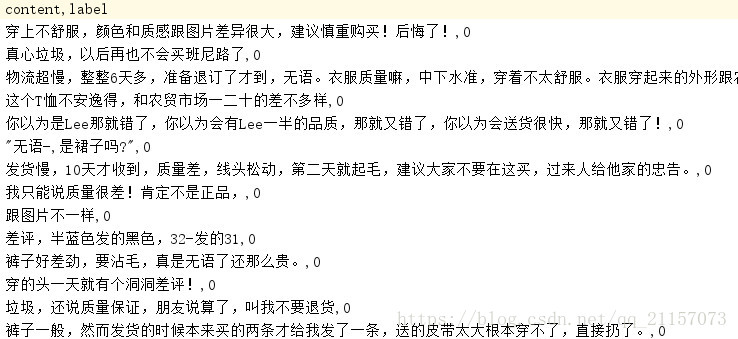同样是CSDN上找到的模型,使用Keras调用LSTM的,70多行,主要看到最底下有模型预测接口,就准备搭一下看看~
【传送门】中文情感分类(基于LSTM)1
2
3
4
5
6
7
8
9
10
11
12
13
14
15
16
17
18
19
20
21
22
23
24
25
26
27
28
29
30
31
32
33
34
35
36
37
38
39
40
41
42
43
44
45
46
47
48
49
50
51
52
53
54
55
56
57
58
59
60
61
62
63
64
65
66
67import pandas as pd
from tensorflow.contrib import learn
from keras.layers.embeddings import Embedding
from keras.layers.recurrent import LSTM
from keras.models import Sequential, load_model
from keras.layers import Dense
import numpy as np
import os
MAX_DOCUMENT_LEN = 30
EMBEDDING_SIZE = 100
def train():
train = pd.read_csv("all.csv", encoding="utf-8")
all_word = set([word for seq in train.content.values for word in list(seq)])
if os.path.exists("processor"):
processor = learn.preprocessing.VocabularyProcessor.restore("processor")
else:
processor = learn.preprocessing.VocabularyProcessor(max_document_length=MAX_DOCUMENT_LEN)
processor.fit(all_word)
processor.save("processor")
# fit generate
def get_generate(batch_size):
while True:
sample_data = train.sample(batch_size)
labels = sample_data.label.values
contents = sample_data.content.values
contents = [list(seq) for seq in contents]
x = []
for seq in contents:
item_str = ""
for word in seq:
item_str += " " + str(word)
x.append(item_str)
x = np.array(list(processor.transform(x)))
y = np.array([[1, 0] if int(item) == 0 else [0, 1] for item in labels])
yield x, y
# create embedding
model = Sequential()
model.add(Embedding(input_dim=len(all_word), output_dim=EMBEDDING_SIZE))
model.add(LSTM(units=128, activation="relu"))
model.add(Dense(2, activation="softmax", name="logit"))
model.compile(loss='categorical_crossentropy', optimizer='sgd')
model.fit_generator(get_generate(50), samples_per_epoch=10000, epochs=10)
model.save("lstm.model")
def pre():
text = input("请输入:")
text = list(text)
item_str = ""
for item in text:
item_str += " " + str(item)
processor = learn.preprocessing.VocabularyProcessor.restore("processor")
input_data = np.array(list(processor.transform([item_str])))
print(input_data)
model = load_model("lstm.model")
target = model.predict(input_data)
print(target)
首先空行在python函数中会被认为函数结束,所以函数中的空行和缩进需要再次检查一遍。
其次
我于是将自己处理的“ipad发布新款-微博评论”csv略修改(加表头、第二列添加0)后放入使用。当时完全没有考虑第二列是什么,只不过看到原文图片中显示的全部为0就以为是作者处理数据留下来的尾巴,我也照着弄就好了,结果导致了后面的问题。
第三,“from tensorflow.contrib import learn”会报错,查资料后发现这一句用到的learn似乎使用到了GCC编译器,于是乎我先去安装了个GCC/G++,然后整好环境变量,此处不再报错。
顺利进行训练(忘记截图了。。。),就是loss率很快就从20掉到3又掉到0.16,在epoch1结束时已经变成了0.0024,收敛速度过快,有点蹊跷。。。
果然在epoch2时loss就止于10^-7这一数量级,一直到训练结束也没再掉一个数量级。
平均一个epoch跑10000个词,用时大约4~5min,整个跑完用了将近1个小时。嗯,,这才是训练模型应该有的样子啊,之前第一个LSTM或许是词语2000太少,十分钟训练完毕?
在我调测试函数时,首先输出的是一个张量而非正向负向,不过【1.0,-0.00..】也能够说明正向负向了。但是在输入明显负向情感时,输出仍然是【1.0.-0.00..】,前置的12维张量明显是字字对应的情感分数,但是为啥后面输出张量就一成不变呢??
后来想想,一是似乎我用的那个“ipad新品发售——微博评论”数据集是自己处理的,可能整体效果不好,并且本身这个数据集对象和极性就不够明显。
我又回头打开那个all.csv文件,猛然想起我的所有标记都写的是0,这个。。。。。
接下来准备用之前第一个LSTM的数据集,先根据已有标注将其汇总到一个csv然后作为数据集再次训练吧。。。这次就当个教训~
